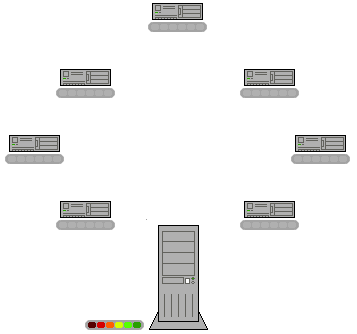Pérez-Reverte y sus Termópilas
Acabo de leer el artÃculo de Arturo Pérez-Reverte en el XLSemanal de esta semana (Nº 1018), y veo que abunda sobre unos argumentos ya utilizados hasta la saciedad por cuatro demagogos.
El artÃculo trata sobre las opiniones vertidas alrededor de la pelÃcula 300, de Zach Snyder. La pelÃcula, como el lector sabrá, relata la épica resistencia en el desfiladero de las Termópilas de 300 soldados espartanos, bajo el mando del rey Leónidas, frente a las huestes de Jerjes, rey de reyes de Persia, en el año 480 A.C. Pérez-Reverte critica la aplicación, por parte de crÃticos de la pelÃcula, de estándares morales actuales a una situación que tiene ya 2500 años (en esto estoy de acuerdo), pero se excede totalmente al hacer una defensa acérrima de lo buenos que eran los griegos.
Me tomo la licencia de citar sus palabras a continuación, y comentar algo sobre ellas:
Al morir de pie, espada en mano, hicieron posible que, aun después de incendiada Atenas, en Salamina, Platea y Micala sobrevivieran Grecia, sus instituciones, sus filósofos, sus ideas y la palabra democracia. Con el tiempo, Leónidas y los suyos hicieron posible Europa, la Enciclopedia, la Revolución Francesa, los parlamentos occidentales, que mi hija salga a la calle sin velo y sin que le amputen el clÃtoris, que yo pueda escribir sin que me encarcelen o quemen, que ningún rey, sátrapa, tirano, imán, dictador, obispo o papa decida –al menos en teorÃa, que ya es algo– qué debo hacer con mi pensamiento y con mi vida. Por eso opino que, en ese aspecto, aquellos trescientos hombres nos hicieron libres. Eran los nuestros.
Comete Pérez-Reverte un número de falacias que no necesitan de mucho conocimiento histórico para rebatir, pero este conocimiento ayuda.
Primero, comete la falacia de post hoc, ergo propter hoc, ya que asume que todas esas cosas “buenas” que hemos tenido y tenemos en Europa, se deben a que aquellos europeos hicieron frente a aquellos asiáticos… pero esto no está para nada demostrado. Complementa esto con una falacia de petición de principio, ya que da por supuesto que si los persas hubiesen ganado, no gozarÃamos de las libertades que menciona, y esto genera el argumento circular de que, por tanto, el que ganaran los griegos fue lo que nos trajo lo que tenemos.
También olvida convenientemente Pérez-Reverte que la batalla ocurrió 500 años antes de que se fundara el cristianismo, y alrededor de 1000 antes de que se fundara el islamismo. Los Papas e Imanes que menciona aparecieron mucho después, y no están realmente muy conectados con la expansión del imperio de Jerjes.
Es más, aún suponiendo que la historia europea sea lo que ha sido gracias a que Grecia resistió ante Persia… ¿a qué viene una selección sesgada de lo “bueno”? ¿Acaso en Europa no hemos tenido una Edad Media llena de oscurantismo? ¿Acaso son los espartanos responsables, por ejemplo, de la Inquisición? ¿Acaso la Revolución Francesa no se llevó a cabo precisamente porque la situación anterior (realeza, nobleza y abusos) era tan nefasta? ¿Y esto no proviene de Grecia y Roma? ¿Gracias a Leónidas las hijas de Pérez-Reverte no llevan velo, pero no debemos a Leónidas el ascenso de Hitler? Es un poco inconsecuente. Al fin y al cabo, si los Persas hubiesen ganado, la Inquisición nunca habrÃa aparecido, ni Hitler hubiera tenido huevos de promover el odio contra los que no fueran “arios”.
Por otro lado, parece que Pérez-Reverte atribuye fanatismo e ignorancia al Irán actual (antigua Persia), y deduce que tales males nos afligirÃan en Europa si Jerjes hubiera ganado. Pero es que 150 años después de Jerjes, hubo un muchacho macedonio rubio y de ojos azules que, antes de morir a los 33 años, unió a toda Grecia y extendió un imperio que llegó a derrotar a Persia, destruyendo su capital, Persépolis, y conquistó Anatolia (TurquÃa), Siria, Fenicia (LÃbano), Judea, Gaza, Egipto, Bactria (Afganistan) y Mesopotamia (Irak). Este chico se llamaba Alejandro Magno.
Ahora bien, ¿no podrÃan los ciudadanos de esos paises quejarse amargamente de que sus hijas tienen que usar velo, y que pueden ser lapidados por sus ideas, por culpa del bárbaro de Alejandro? ¿No podrÃa argumentarse que mejor les habrÃa ido si Jerjes hubiera conquistado Grecia, y que el mal que puedan sufrir no es culpa del Imperio Persa, sino del Imperio Macedonio?
La respuesta, obviamente, es no. Ni nuestra Enciclopedia se la debemos a Leónidas, ni el fanatismo religioso en oriente medio se lo deben a Alejandro. Asignar responsabilidades y gratitudes históricas, remontándose a 2500 años atrás, es un acto tan irresponsable como el juzgar a aquellos griegos con nuestra moral de ahora. Lo triste es que Pérez-Reverte ha visto el error de esto último, pero no el de lo primero. Lamentable.


